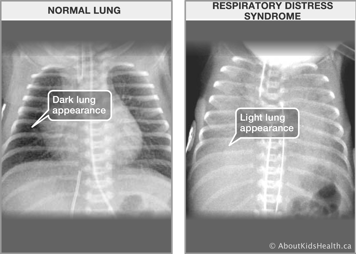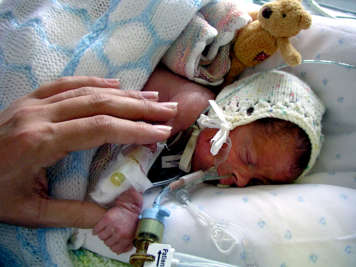Surfactant is a substance that develops in the lungs and helps keep them inflated. If a baby is born prematurely, they may not have developed surfactant and can have difficulty inflating their lungs. This condition is called respiratory distress syndrome, or RDS.
Normally, when the lungs expand with the newborn baby's first breath, the air sacs fill with air and remain open. These air sacs are called alveoli. Surfactant is a kind of foamy, fatty liquid that acts like grease. It is produced in the lungs and helps the lungs inflate by preventing the insides of the lungs from sticking together during breathing.
In the lungs, oxygen and carbon dioxide are exchanged in the alveoli. This is the essential part of breathing, and it is much more difficult to do if there is not enough surfactant at birth.
Surfactant usually appears in the fetus's lungs at about the 24th week of pregnancy and gradually builds up to its full level by about the 35th week. Premature babies are most at risk for RDS.

Signs and symptoms of RDS in babies
A baby with RDS may have any of the following signs and symptoms:
- Rapid breathing, which may indicate that the baby is working harder to eliminate the carbon dioxide from the blood by increasing the frequency of breaths. Carbon dioxide is the waste product of breathing.
- Noisy breathing that sounds like a grunt. With each exhalation, babies with RDS forcibly try to hold a little bit of volume in their lung with each breath to try to reinflate some of the collapsed alveoli. The noise produced is referred to as a “grunt.”
- Powerful sucking in of the chest with each breath exposing the ribs beneath the skin. Indrawing often looks as if the chest wall is collapsing inward with each respiration and can be mild to severe.
- Low levels of oxygen on the oxygen saturation monitor.
These are all signs of difficulty breathing and are not specific to RDS. Premature babies with breathing difficulties caused by other conditions may also have some of the signs and symptoms listed above.
What causes RDS in premature babies?
RDS is caused by a lack of surfactant that occurs in the immature lungs. This is why prematurity is the greatest risk factor. The more immature a baby is, the more likely it is that they will develop RDS.
The condition is generally progressive in that the breathing difficulties experienced by the baby begin immediately at birth and worsen over time. RDS typically improves after babies receive breathing assistance and surfactant. The severity of RDS and its progression have to do with the maturity of the lung.
How is RDS diagnosed?
All premature babies with breathing problems of any type are carefully monitored to assess the severity of the breathing problem, to detect changes and to follow progress. Their breathing and heart rate are closely monitored, as is the measurement of oxygen saturation (oximetry), which is an indirect way of measuring the oxygen level in the blood. A small light is attached to one of the baby’s extremities, usually the hand or foot. As the light passes through the child’s body, the light is measured to indicate how much oxygen is in the blood. Oximetry can confirm that a baby is breathing the appropriate amount of oxygen. A blood gases test measures the amount of oxygen, carbon dioxide and acid in the blood. These three measures indicate the severity of the baby’s respiratory distress. The blood gas specimen is obtained from an artery or by heel prick.
A chest X-ray will confirm the diagnosis in a premature baby with signs and symptoms of breathing difficulties. The X-ray often shows:
- small lung volume
- air bronchograms or air in the airways of the lung that are black in comparison to the surrounding white areas that do not contain air
- granular-looking areas on the lung where the lung resembles white salt and black pepper being sprinkled on the film. The more pepper, the more aeration; the more salt, the more collapse or fluid.

Often a newborn baby suspected of having a surfactant deficiency, especially if they are less than 30 weeks' gestation, will be given surfactant replacement therapy immediately and will then be monitored for signs of improved lung function. Although this does not confirm RDS, it is a sensible, rational and safe way to proceed.
How is RDS treated?

The treatment of RDS depends on the severity of the condition. Some babies are treated with supplemental oxygen and breathing support, and others require surfactant replacement. Supplemental oxygen and breathing support can be delivered by one of these ventilation methods:
- continuous positive airway pressure (CPAP)
- high-flow nasal cannula (HFNC)
- conventional mechanical ventilation (CMV)
- high-frequency oscillation (HFO)
- high-frequency jet ventilation (HFJV)
Surfactant replacement therapy
Surfactant is available as a medication to treat babies with RDS. It is a liquid that is derived from animals or is synthetically produced and can be administered into a baby’s lungs. There are several different methods that are used to administer surfactant. Depending on the severity of the lung condition, surfactant may be administered more than once.
Extremely premature babies who have RDS and require mechanical ventilation will often be given surfactant replacement prior to transfer to another hospital.

Prevention of RDS
RDS can be prevented in premature babies by administering steroids to the pregnant parent before delivery. Steroids can initiate or speed up production of surfactant in the lungs of the fetus. After birth, the baby can receive surfactant and breathing assistance with a machine to help with ventilation.
Possible complications of RDS
The more immature a baby is, the more likely they are to develop complications, and the more severe those complications are likely to be. If RDS is not treated, it can lead to the need for prolonged mechanical ventilation, which can in turn increase the likelihood of developing chronic lung disease.
Long-term outcomes
The overwhelming majority of newborn babies fully recover from RDS with no long-term lung problems. However, newborn babies with severe RDS, usually the smallest and most premature babies, are at risk for future breathing difficulties, including chronic lung disease.
References
Canadian Paediatric Society. (February 1, 2021). Guidelines for surfactant replacement therapy in neonates. Retrieved from: https://cps.ca/documents/position/guidelines-for-surfactant-replacement-therapy-in-neonates